动名词的用法
动名词的用法

动名词的用法动名词是一种兼有动词和名词特征的非限定动词。
它可以支配宾语,也能被副词修饰。
动名词有时态和语态的变化。
一、动名词的作用动名词具有名词的性质,因此在句中可以做主语、表语、宾语、定语等。
1、做主语Reading is an art. 读书是一种艺术。
Climbing mountains is really fun. 爬山是真有趣。
Working in these conditions is not a pleasure but a suffer. 在这种工作条件下工作不是愉快而是痛苦。
动名词做主语,有时先用it作形式主语,把动名词置于句末。
这种用法在习惯句型中常用。
如:It is no use/no good crying over spilt milk. 洒掉的牛奶哭也没用。
It is a waste of time persuading such a person to join us. 劝说这样的人加入真是浪费时间。
It was hard getting on the crowded street car. 上这种拥挤的车真难。
It is fun playing with children. 和孩子们一起玩真好。
There is no joking about such matters. 对这种事情不是开玩笑。
2、作宾语(1)作动词的宾语某些动词后出现非限定性动词时只能用动名词作宾语,不能用不定式。
常见的此类动词有:advise, allow, permit, avoid, consider, enjoy, finish, give up, cannot help, imagine, include, keep, keep on, mind, miss, put off, delay, practise, resist, suggest, depend on, think about, set about, succeed in, worry about, burst out, insist on, can’t stand, be used to, get used to, devote…to…, look forward to, pay attention to, get down to等。
动名词的三种用法

动名词的三种用法
1、动名词的一般用法
动名词的基本词义是“做某件事”,所以用作主语、表语或宾语等成分时,表示正在或即将做某件事。
如:
Beating drums is a popular way to celebrate the Dragon Boat Festival.
(敲鼓是庆祝端午节的一种流行方式。
)
2、动名词的现在分词用法
除口语外,动名词做主语、宾语、表语或补语时,常可改用现在分词形式,此时动词的意义变为事情正在进行及其结果,即过去式表示的“做某件事”,改用现在分词表示“做某件事的结果”,表示持续状态或即时动作。
如:
Seeing is believing.
(眼见为实。
)
3、动名词的过去分词用法
常常在下列句型中用动名词的过去分词形式:
1) It/This/That + be + 过去分词;
2) have /had + 过去分词;
3) 介词+ 过去分词;
4) 情态动词 + 过去分词.
如:
(1) It is said that she has been married.
(据说她已经结婚了。
)
(2) He had his hair cut yesterday.
(他昨天理了发。
)
(3) After graduating from university, he went abroad for further study.
(大学毕业后,他出国深造。
)
(4) He might have been asleep when you called.
(你打电话时,他可能正在睡觉。
动名词的用法详解
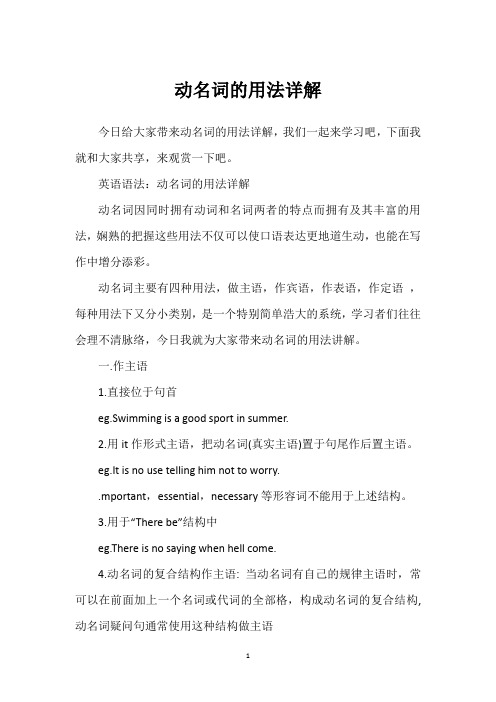
动名词的用法详解今日给大家带来动名词的用法详解,我们一起来学习吧,下面我就和大家共享,来观赏一下吧。
英语语法:动名词的用法详解动名词因同时拥有动词和名词两者的特点而拥有及其丰富的用法,娴熟的把握这些用法不仅可以使口语表达更地道生动,也能在写作中增分添彩。
动名词主要有四种用法,做主语,作宾语,作表语,作定语,每种用法下又分小类别,是一个特别简单浩大的系统,学习者们往往会理不清脉络,今日我就为大家带来动名词的用法讲解。
一.作主语1.直接位于句首eg.Swimming is a good sport in summer.2.用it作形式主语,把动名词(真实主语)置于句尾作后置主语。
eg.It is no use telling him not to worry..mportant,essential,necessary等形容词不能用于上述结构。
3.用于“There be”结构中eg.There is no saying when hell come.4.动名词的复合结构作主语: 当动名词有自己的规律主语时,常可以在前面加上一个名词或代词的全部格,构成动名词的复合结构,动名词疑问句通常使用这种结构做主语eg.Their coming to help was a great encouragement to us.Does your saying that mean anything to him?二.作宾语1.作动词的宾语某些动词后消失非限定性动词时只能用动名词作宾语,不能用不定式。
不定式通常指某种特定的动作,但动名词表示泛指,常见的此类动词有:admit,appreciate,excuse,stand,advise,allow,permit,avoid,consider,enjoy,f inish,give up,cannot help,imagine,include,keep,understand,keepon,mind,report,risk,miss,put off,delay,practise,resist,suggest,depend on,think about,set about,succeed in,worry about,burst out,insist on,feel like,be used to,get used to,devote…to…,look forward to,pay attention to,get down to,escape and so on.eg.They went on walking and never stopped talking.他们连续走,说个不停。
动名词的用法和变化

动名词的用法和变化
动名词是动词变化形式的一种,它以-ing结尾,可以作为名词使用。
本文将介绍动名词的主要用法和变化形式。
用法
1. 动名词作主语:动名词可以单独作句子的主语,例如:“Swimming is my favorite hobby.”(游泳是我最喜欢的爱好。
)
2. 动名词作宾语:动名词可以作及物动词的宾语,例如:“I enjoy reading books.”(我喜欢读书。
)
3. 动名词作介词的宾语:动名词可以作介词的宾语,例如:“She is thinking about going abroad.”(她正在考虑出国。
)
4. 动名词作定语:动名词可以作名词的定语,例如:“The running water is so refreshing.”(流动的水非常清新。
)
变化形式
动名词的变化形式有以下几种:
1. 一般形式:直接在动词后面加-ing。
例如:“playing”(玩耍)、“writing”(写作)。
2. 变化形式:当动词以-e结尾时,去掉e并加-ing。
例如:“take”变为“taking”。
3. 变化形式:当动词以-ie结尾时,改变ie为y并加-ing。
例如:“die”变为“dying”。
4. 变化形式:当动词以辅音字母结尾的重读闭音节时,双写结
尾的辅音字母并加-ing。
例如:“run”变为“running”。
注意:部分动词的变化形式可能不按上述规则变化,需具体辨别。
动名词的用法和变化形式是英语学习的基础知识之一,希望本
文的介绍能帮助您更好地理解和运用动名词。
动名词的用法总结

动名词的用法总结动名词是英语中的一种特殊的词形,它在句子中兼具动词和名词的功能。
在语法上,动名词常作主语、宾语、补足语等,并且可以和其他单词进行连用。
以下是动名词的常见用法总结。
1. 动名词作主语动名词可以作为句子的主语,引导句子的重点内容。
常见的结构是“动名词 + 谓语动词”。
例如:`吃水果有助于保持健康。
`在上述例句中,动名词“吃水果”作为主语,表达了“有助于保持健康”的概念。
2. 动名词作宾语动名词可以作为句子的宾语,接在及物动词之后。
常见的结构是“动词 + 动名词”。
例如:`我喜欢读书。
`在上述例句中,“喜欢”是及物动词,后面跟着动名词“读书”,表示喜欢进行读书这一行为。
3. 动名词作补足语动名词可以作为某些动词的补足语,用来补充说明主语的情况或感受。
常见的动词包括“feel”(感觉)、“find”(发现)、“keep”(保持)等。
例如:`我发现研究是一种持续的过程。
`在上述例句中,“发现”是动词,后面跟着动名词“研究”,表示主语发现了研究是一种持续的过程。
4. 动名词作定语动名词可以作为名词的定语,用来修饰名词。
常见的结构是“动名词 + 名词”。
例如:`跑步锻炼对身体健康很好。
`在上述例句中,“锻炼”是动名词,修饰名词“跑步”,表示通过跑步来进行锻炼对身体健康很好。
5. 动名词作介词宾语动名词可以作为介词的宾语,跟在介词之后。
常见的结构是“介词 + 动名词”。
例如:`我对于旅行有着浓厚的兴趣。
`在上述例句中,“对于”是介词,后面跟着动名词“旅行”,表示主语对旅行有浓厚的兴趣。
6. 动名词作目的状语动名词可以作为句子的状语,表示动作的目的或原因。
常见的结构是“动名词 + 动词”。
例如:`我去图书馆借书研究。
`在上述例句中,“借书研究”是动名词作为目的状语,说明主语去图书馆的目的是为了借书研究。
综上所述,动名词在句子中有多种不同的用法,包括作主语、宾语、补足语、定语、介词宾语和目的状语等。
动名词的用法

动名词的用法
动名词是一种特殊的名词形式,可以表示动作、状态或者抽象概念。
下面是动名词在句子中的常见用法:
1. 主语:
动名词可以作为句子的主语。
例如:
- ___.(游泳是我最喜欢的运动。
)
- Running ___.(每天早上跑步让我保持健康。
)
2. 宾语:
动名词可以作为动词的宾语。
例如:
- ___.(我喜欢弹钢琴。
)
- ___.(她讨厌做家务。
)
3. 介词宾语:
有些动词需要结合介词后面接动名词作宾语。
例如:
- He is good at playing basketball.(他擅长打篮球。
)
- ___(她对研究外语感兴趣。
)
4. 形容词后置:
有些形容词后面可以接动名词作为定语。
例如:
- The running water is so refreshing.(流动的水非常清凉。
)
- ___ party.(我为聚会买了一件舞蹈服。
)
5. 动名词短语:
动名词可以与其他词组成动名词短语,充当名词的一部分。
例如:
- ___.(我喜欢在海洋里游泳。
)
- The teacher ___.(老师负责批改试卷。
)
需要注意的是,动名词的构成是在动词原形后面加上-ing。
有些情况下,动名词与动词的原形相同,但语法角色不同。
在使用动名词时,需要根据语境和句子结构来判断合适的使用方式。
同时,要注意动名词的时态和语态与其他动词形式的搭配。
动名词的用法

动名词的用法动名词是一种非限定形式的动词,它同时具有动词和名词的特征,可以带宾语或被状语修饰。
动名词还可以构成动名词短语,有时态和语态的变化。
动名词的基本形式是由动词原形加词尾-ing构成,与现在分词形式相同。
与此不同,现在分词常常表示动作或状态,例如“a sleeping chair”(躺/睡椅)和“a sleeping child”(正在睡觉的孩子)。
动名词在句中可以作主语、表语、宾语、定语等名词性成分。
作主语时,动名词可以直接位于句首,例如“Reading is an art”(读书是一种艺术)和“Climbing mountains is really fun”(爬山真是有趣)。
此时,谓语动词要用单数形式。
另外,动名词还可以用it作形式主语,将真实主语置于句尾作后置主语,例如“It is no use crying over spilt milk”(覆水难收)和“It is fun playing with children”(和孩子们一起玩真好)。
这种用法在惯句型中很常见。
动名词还可以用于“There be”结构中,例如“There is no saying wh en he'll come”(很难说他何时回来)和“XXX”(对这种事情不是开玩笑)。
需要注意的是,形容词important、essential和necessary等后面不能用动名词,而应该使用不定式。
The wheel of history cannot be ped。
This common phrase XXX.Common sentence structure: There is no + gerund = It isXXX do。
Note: In the "There be" sentence structure。
only gerunds can be used as the subject。
动名词的用法归纳总结
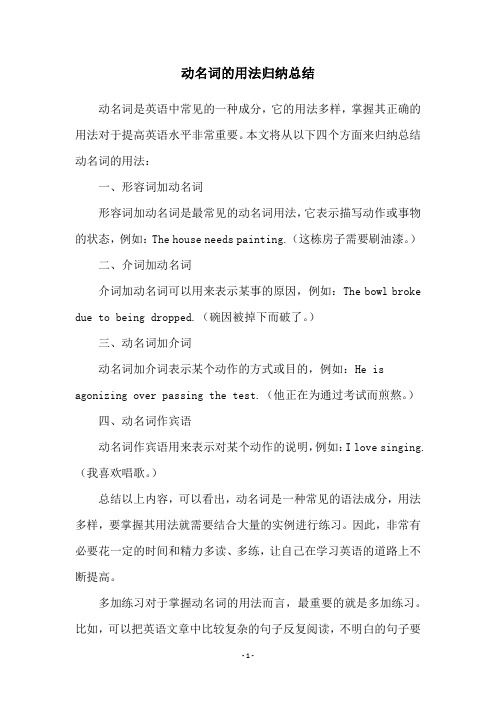
动名词的用法归纳总结动名词是英语中常见的一种成分,它的用法多样,掌握其正确的用法对于提高英语水平非常重要。
本文将从以下四个方面来归纳总结动名词的用法:一、形容词加动名词形容词加动名词是最常见的动名词用法,它表示描写动作或事物的状态,例如:The house needs painting.(这栋房子需要刷油漆。
)二、介词加动名词介词加动名词可以用来表示某事的原因,例如:The bowl broke due to being dropped.(碗因被掉下而破了。
)三、动名词加介词动名词加介词表示某个动作的方式或目的,例如:He is agonizing over passing the test.(他正在为通过考试而煎熬。
)四、动名词作宾语动名词作宾语用来表示对某个动作的说明,例如:I love singing.(我喜欢唱歌。
)总结以上内容,可以看出,动名词是一种常见的语法成分,用法多样,要掌握其用法就需要结合大量的实例进行练习。
因此,非常有必要花一定的时间和精力多读、多练,让自己在学习英语的道路上不断提高。
多加练习对于掌握动名词的用法而言,最重要的就是多加练习。
比如,可以把英语文章中比较复杂的句子反复阅读,不明白的句子要多加做笔记,理解的句子要做记号,以便日后复习时更加容易理解。
通过多种练习,学生可以慢慢掌握动名词的用法,加快自己的学习进度。
动名词学习计划为了让学生更好地掌握动名词的用法,可以设计一份动名词学习计划,并制定学习步骤,以便有条不紊地进行学习。
比如,第一步可以把动名词有关的内容全部归纳总结,包括其定义、结构和引入语等等,然后通过背诵、交际、翻译等操练熟悉用法;第二步可以使用典型的实例进行记忆和运用,并在读写实践中有所成效;第三步可以做一些模拟题、把练习题分成不同的难度,以便达到灵活应用动名词的能力;第四步可以安排新闻报纸、电视剧、小说等多种形式的英语素材,使用动名词,运用自身的分析和总结能力。
动名词的用法总结详解英语语法

动名词的用法总结详解英语语法动名词词在句子中可以用作主语、表语、宾语、补足语、定语、状语等。
以下是店铺为大家整理的动名词的用法,希望能帮助大家更好地掌握动名词,提高英语水平。
动名词的用法:作主语1、动名词是由动词变化而来,所以,动名词的意义也是表示某个动作或事情。
例如: Reading English aloud in the morning will do you a lot of good.Cheating on an exam ruins one's character. 考试作弊毁坏人的性格。
2、动名词作主语时,对于一些比较长的动名词短语,一般采用"It is …"和"There is …"两种句式来表示。
例如:It is no use waiting for him any longer. 等他是没有用的。
There is no joking about such matters. 这种事开不得玩笑。
3、动名词作主语与不定式作主语的区别:动名词作主语通常表示抽象的或泛指的动作,一般不与特定的动作执行者联系在一起;不定式作主语通常表示具体的动作或行为,往往与特定的动作执行者联系在一起,如:It’s no use crying over spilt milk. (抽象)He realized that to go on like this was no use. (具体)4、在实际运用中,一般可以互换,差异不大。
但在下列几种情况中不能互换:当表语是动名词时,主语也要用动名词;当表语是不定式时,主语也要用不定式,如: Seeing is believing. = To see is to believe.5、动名词和不定式作主语,一般都可以使用形式主语it,而将动名词或不定式放在句尾。
但是在下列句型中,一般宜用动名词,不宜用不定式来代替:It’s no use doing … It’s no good doing…It’s a waste of time doing …动名词的用法:作表语1、动名词作表语与现在分词作表语的区别:动名词作表语时相当于名词,说明主语的含义及内容,它与主语是同等关系,主语与表语互换位置不影响句子的基本含义,但不可用副词来修饰。
动名词的用法总结
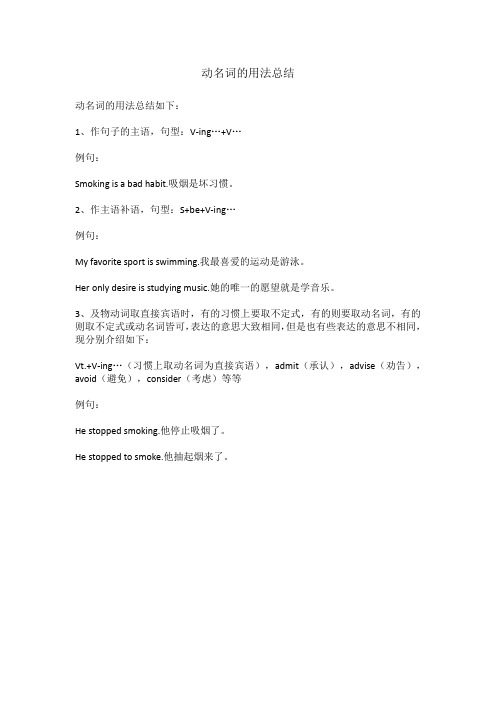
动名词的用法总结
动名词的用法总结如下:
1、作句子的主语,句型:V-ing…+V…
例句:
Smoking is a bad habit.吸烟是坏习惯。
2、作主语补语,句型:S+be+V-ing…
例句:
My favorite sport is swimming.我最喜爱的运动是游泳。
Her only desire is studying music.她的唯一的愿望就是学音乐。
3、及物动词取直接宾语时,有的习惯上要取不定式,有的则要取动名词,有的则取不定式或动名词皆可,表达的意思大致相同,但是也有些表达的意思不相同,现分别介绍如下:
Vt.+V-ing…(习惯上取动名词为直接宾语),admit(承认),advise(劝告),avoid(避免),consider(考虑)等等
例句:
He stopped smoking.他停止吸烟了。
He stopped to smoke.他抽起烟来了。
动名词用法

★动名词口诀动名词真正好,可作主、宾可作表;物主名代所有格,逻主还可用宾格;主动形式ing,被动形式being done;句首为主,谓为单,否定直接加在前。
★口诀详解1、动名词真正好,可作主、宾可作表动名词,顾名思义,带有动词功能的名词,可以作主语、宾语、表语,如:Seeing is believing. (眼见为实)。
在这句话中,动名词作的就是主语和表语。
再比如:Jack would not mind working with female colleagues. (杰克不介意和女同事一起工作)。
此时working作的就是谓语动词mind的宾语。
注意:动名词尽管不是动词,但依然保持着动词的特性。
如果是及物动词转化而来的动名词,后面可以带自己的宾语,如:We often practice speaking English. (我们经常练习说英语)。
2、物主名代所有格,逻主还可用宾格动名词前面可以加上物主代词或名词的所有格(有时可以用宾格),来表明其动作的发出者(即其逻辑上的主语),如:I would appreciate _______ back this afternoon.A. you to callB. you callC. you callingD. you're calling答案:选C。
如果选项中出现your calling,也是可以选的。
注意:①如果动名词的逻辑主语是无生命的名词或抽象名词,则用名词的普通格,如:I know nothing about the window being open. 我不知道窗户开着。
②如果动名词的逻辑主语是两个或两个以上的代词,则用代词的宾格,如:I objected to you and him going together. 我反对你和他在一起。
3、主动形式ing,被动形式being done一般形式:I don't like you smoking. 我不喜欢你抽烟。
动名词的用法讲解

动名词的用法讲解
动名词是指以-ing结尾的词,它既有动词的意义,又有名词的功能。
动名词通常用来表示某种行动或状态的持续性、重复性或延续性。
常见的用法有以下几种:
1. 作主语/宾语:Walking is good for your health.(散步对
健康有益)
2. 作介词宾语:I’m interested in learning English.(我对学习
英语很感兴趣)
3. 作定语:The running water sounds relaxing.(流水声很令人放松)
4. 作表语:Her favorite hobby is singing.(她最喜欢的爱好是唱歌)
5. 作补语:I enjoy swimming in the sea.(我喜欢在海里游泳)
6. 作复合宾语:She kept practicing speaking English.(她一直
保持练习说英语)
需要注意的是,动名词还可以与情态动词、助动词、不定式构成
复合结构,例如:He should stop smoking(他应该戒烟)。
此外,
有些动词后既可以跟动名词,也可以跟不定式,但意义有所不同,例如:remember doing sth.(记得做过某事)和 remember to do sth.(记得去做某事)。
总之,动名词在英语中是一种非常常见的词类,掌握它的用法能
够大大提高语言表达能力。
动名词用法的归纳
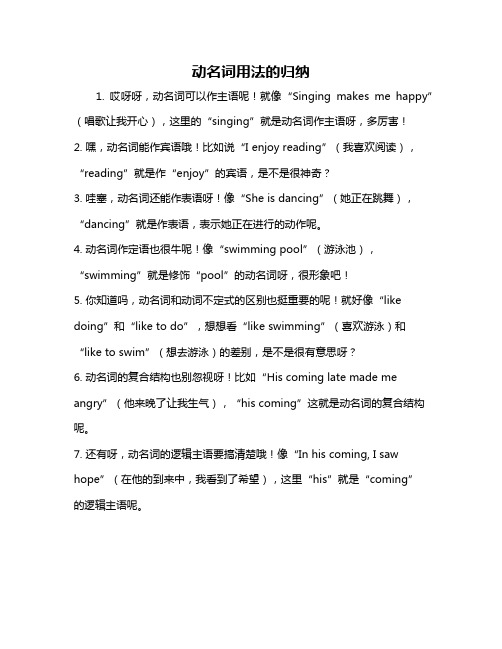
动名词用法的归纳1. 哎呀呀,动名词可以作主语呢!就像“Singing makes me happy”(唱歌让我开心),这里的“singing”就是动名词作主语呀,多厉害!2. 嘿,动名词能作宾语哦!比如说“I enjoy reading”(我喜欢阅读),“reading”就是作“enjoy”的宾语,是不是很神奇?3. 哇塞,动名词还能作表语呀!像“She is dancing”(她正在跳舞),“dancing”就是作表语,表示她正在进行的动作呢。
4. 动名词作定语也很牛呢!像“swimming pool”(游泳池),“swimming”就是修饰“pool”的动名词呀,很形象吧!5. 你知道吗,动名词和动词不定式的区别也挺重要的呢!就好像“like doing”和“like to do”,想想看“like swimming”(喜欢游泳)和“like to swim”(想去游泳)的差别,是不是很有意思呀?6. 动名词的复合结构也别忽视呀!比如“His coming late made me angry”(他来晚了让我生气),“his coming”这就是动名词的复合结构呢。
7. 还有呀,动名词的逻辑主语要搞清楚哦!像“In his coming, I saw hope”(在他的到来中,我看到了希望),这里“his”就是“coming”的逻辑主语呢。
8. 动名词的时态和语态也得注意呢!“Having been done”这样的形式可别搞混啦,就好像“Having been told many times, he still made the same mistake”(已经被告诉很多次了,他还是犯同样的错误)。
9. 哎呀,说了这么多动名词的用法,大家可得好好记住呀!这样才能在英语学习中更加得心应手呀!我的观点就是动名词的用法丰富多彩,大家一定要认真掌握呀!。
动名词的三种用法
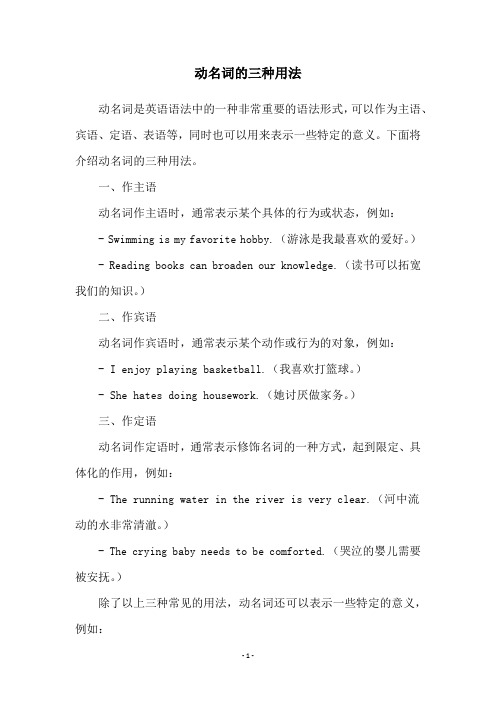
动名词的三种用法动名词是英语语法中的一种非常重要的语法形式,可以作为主语、宾语、定语、表语等,同时也可以用来表示一些特定的意义。
下面将介绍动名词的三种用法。
一、作主语动名词作主语时,通常表示某个具体的行为或状态,例如:- Swimming is my favorite hobby.(游泳是我最喜欢的爱好。
) - Reading books can broaden our knowledge.(读书可以拓宽我们的知识。
)二、作宾语动名词作宾语时,通常表示某个动作或行为的对象,例如:- I enjoy playing basketball.(我喜欢打篮球。
)- She hates doing housework.(她讨厌做家务。
)三、作定语动名词作定语时,通常表示修饰名词的一种方式,起到限定、具体化的作用,例如:- The running water in the river is very clear.(河中流动的水非常清澈。
)- The crying baby needs to be comforted.(哭泣的婴儿需要被安抚。
)除了以上三种常见的用法,动名词还可以表示一些特定的意义,例如:- V-ing + V-ed:表示同时或顺序进行的两个动作,如:He sat there, reading a book and drinking tea.(他坐在那里,一边看书一边喝茶。
)- V-ing + to-inf:表示动作的目的,如:He went there, hoping to meet his friend.(他去那里,希望能见到他的朋友。
)- V-ing + V-ing:表示两个动作同时进行,如:She was walking down the street, humming a song.(她一边走在街上,一边哼着歌。
)总之,动名词的用法非常丰富多样,对于英语学习者来说,掌握好动名词的使用,能够更加流利自如地表达自己的意思。
英语动名词的用法

英语动名词的用法动名词的用法动名词是非谓语动词的一种,它由动词原形加-ing构成,形式上与现在分词相同。
动名词除具有动词的性质外,还具有名词的性质。
动名词在句中可用作主语、表语、宾语、定语、宾语补足语等,但不能用作谓语(故称动名词为非谓语动词)。
如:Her job is looking after the baby. 她的工作是照顾婴儿。
She loves swimming. 她喜欢游泳。
Thank you for helping us. 谢谢你帮助我们。
She’s gone out to do some shopping. 她出去买东西了。
一、动名词的句法功能1.用作主语Seeing is believing. 眼见为实。
Finding work is difficult these days. 现在找工作可不容易。
注意:动名词作主语经常采用it作形式主语的句型。
It’s no good talking. 空谈没有什么用处。
It’s no use crying. 哭没有什么用处。
2.用作表语Her favorite sport is skating. 她最喜爱的运动是滑冰。
His job is teaching English. 他的工作是教英语。
注意:不定式和动名词均可用作主语和表语,区别是:动名词多指笼统的、抽象的概念,而不定式则多指具体的、一次性的动作。
3.用作宾语She likes singing and dancing. 她喜欢唱歌跳舞。
He enjoys playing basketball. 他喜爱打篮球。
介词后出现动词时,通常要用动名词形式,不能用动词原形,通常也不用不定式。
Thank you for helping us. 谢谢你帮助我们。
He left without saying good-bye. 他没有告别就离开了。
4.用作定语This is our reading room. 这时我们的阅览室。
动名词的用法
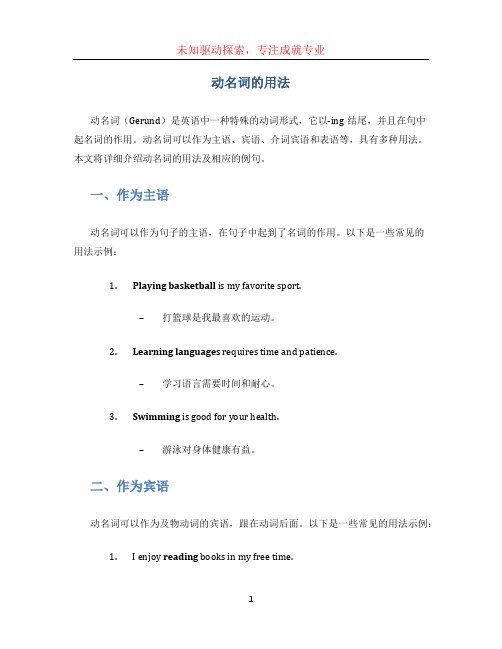
动名词的用法动名词(Gerund)是英语中一种特殊的动词形式,它以-ing结尾,并且在句中起名词的作用。
动名词可以作为主语、宾语、介词宾语和表语等,具有多种用法。
本文将详细介绍动名词的用法及相应的例句。
一、作为主语动名词可以作为句子的主语,在句子中起到了名词的作用。
以下是一些常见的用法示例:1.Playing basketball is my favorite sport.–打篮球是我最喜欢的运动。
2.Learning languages requires time and patience.–学习语言需要时间和耐心。
3.Swimming is good for your health.–游泳对身体健康有益。
二、作为宾语动名词可以作为及物动词的宾语,跟在动词后面。
以下是一些常见的用法示例:1.I enjoy reading books in my free time.–我空闲时喜欢读书。
2.They avoid eating junk food.–他们避免吃垃圾食品。
3.She prefers watching movies to going shopping.–她喜欢看电影而不是逛街。
三、作为介词宾语动名词可以作为介词的宾语,放在介词后面。
以下是一些常见的用法示例:1.He is good at playing the piano.–他擅长弹钢琴。
2.We are interested in learning new things.–我们对学习新事物感兴趣。
3.She is afraid of flying in airplanes.–她害怕坐飞机。
四、作为表语动名词可以作为系动词的表语,说明主语的身份或特征。
以下是一些常见的用法示例:1.Her favorite activity is painting.–她最喜欢的活动是绘画。
2.The best thing for you is relaxing.–对你来说最好的事情是放松。
高考英语动名词用法

高考英语动名词用法动词-ing形式在英语中被称为动名词,它可以作为名词使用。
在高考英语中,要求掌握动名词的正确运用,本文将详细介绍动名词的用法。
1. 作为主语:动名词可以作为句子的主语,表示一种具体的行为或活动。
例如:Swimming is my favorite sport.翻译:游泳是我最喜欢的运动。
2. 作为宾语:动名词可以作为及物动词或不及物动词的宾语。
例如:I enjoy reading novels in my free time.翻译:我喜欢在空闲时间里读小说。
3. 作为介词宾语:动名词可以作为介词的宾语,常见的介词有:for, in, of, about, with 等。
例如:He is interested in learning new languages.翻译:他对学习新语言很感兴趣。
4. 作为表语:动名词可以作为连系动词的表语,表示主语所具有的特征或性质。
例如:Her favorite activity is jogging in the park.翻译:她最喜欢在公园慢跑。
5. 作为定语:动名词可以作为名词的定语,修饰名词。
例如:Playing soccer is a popular sport in our school.翻译:踢足球是我们学校流行的运动。
6. 作为宾语补足语:某些动词后接动名词作为宾语补足语,表示动作的延续。
例如:I saw him dancing at the party.翻译:我看到他在派对上跳舞。
7. 作为状语:动名词可以作为句子的状语,表示伴随的动作。
例如:She listened to music while studying.翻译:她一边学习一边听音乐。
8. 作为动词的宾语补足语:某些动词后接动名词作为宾语补足语,表示动作的结果或程度。
例如:I found her crying in her room.翻译:我发现她正在房间里哭泣。
9. 作为动词的宾语:某些动词后接动名词作为宾语,表示动作的对象。
- 1、下载文档前请自行甄别文档内容的完整性,平台不提供额外的编辑、内容补充、找答案等附加服务。
- 2、"仅部分预览"的文档,不可在线预览部分如存在完整性等问题,可反馈申请退款(可完整预览的文档不适用该条件!)。
- 3、如文档侵犯您的权益,请联系客服反馈,我们会尽快为您处理(人工客服工作时间:9:00-18:30)。
动名词定义:动名词是动词的一种非限定形式,兼有动词和名词的特征,它可以带宾语,也能被状语修饰。
动名词接宾语或状语构成动名词短语。
动名词有时态和语态的变化。
基本形式:由动词原形家词尾-ing构成,与现在分词形式相同。
动名词已经名词化了,而现在分词常表示动作或状态。
如:a sleeping chair 躺/睡椅(动名词,表用途) a sleeping child 正在睡觉的孩子(现在分词,表状态)一、动名词的句法功能动名词具有名词的性质,因此在句中可以作主语、表语、宾语、定语等。
1、作主语1)直接位于句首做主语。
Reading is an art. 读书是一种艺术。
Climbing mountains is really fun. 爬山真是有趣。
Working in these conditions is not a pleasure but a suffering. 在这种工作条件下工作不是一件愉快的事而是一件痛苦的事。
注意:动名词做主语时,谓语动词为单数2)用 it 作形式主语,把动名词(真实主语)置于句尾作后置主语。
It is no use/no good crying over spilt milk. 覆水难收It is a waste of time persuading such a person to join us. 劝说这样的人加入真是浪费时间。
It was hard getting on the crowded street car. 上这种拥挤的车真难。
It is fun playing with children. 和孩子们一起玩真好。
这种用法在习惯句型中常用,常用句型:It is + no use/no good/useless/senseless/fun/enjoyable/tiring/interesting/foolish/nice/a waste of time/a plessure… + v.ing注意:important,essential,necessary 等形容词后面不用动名词(常用不定式)。
3)用于“There be”结构中。
There is no saying when he'll come.很难说他何时回来。
There is no joking about such matters. 对这种事情不是开玩笑。
There is no holding back the wheel of history. 历史的车轮不可阻挡。
常用句型:There is no + v.ing = It is impossible to do …注意:在“There be”句型中,只能用动名词,而不能用不定式作主语。
4)用于布告形式的省略结构中。
No smoking ( =No smoking is allowed (here) ). 禁止吸烟。
No parking. 禁止停车。
5)动名词的复合结构作主语当动名词有自己的逻辑主语时,常可以在前面加上一个物主代词或名词所有格,构成动名词的复合结构。
动名词的复合结构也可以在句中作主语。
例如:Their coming to help was a great encouragement to us.他们前来帮忙对我们来说是极大的鼓舞。
Lao Li’s going there won’t be of much help.老李去不会有多大帮助。
2、作宾语(1)作动词的宾语某些动词后出现非限定性动词时只能用动名词作宾语,不能用不定式。
常见的此类动词有:advise, suggest, allow, permit, avoid, consider, enjoy, finish, cannot help, imagine, include, keep, keep on, mind, miss, delay, practise, resist, postpone(推迟),deny(否认), appreciate (欣赏,感激), escape, excuse, pardon, can’t stand, put off, give up等。
如:Would you mind opening the window?吧窗户打开好吗?She suggested going to the Great Wall for the spring outing. 她建议去长城春游。
Seeing the picture, he couldn’t help laug hing. 看了这幅画,他禁不住大笑起来。
Mark often attempts to escape being fined whenever he breaks traffic regulations.每当马克违反交通规则时,他常常企图逃避罚款的处分。
在下面这种结构中也可以用动名词(短语)做宾语:find/think/consider… + it(形式宾语)+ no use/no good/useless… + v.ing(真正宾语).I found it pleasant walking along the seashore. 在海滩上走真是乐事。
Do you consider it any good trying again? 你认为再试一次有好处吗?*形容词worth后也可接动名词,作为复合谓语的宾语。
The music is well worth listening to more than once. 这种曲子很值得多听几遍。
(2)作介词的宾语*能接动名词的短语有:think of/about, dream of/about, hear of,preven t/keep/stop…from…, depend on, set about, succeed (in), worry about, burst out, insist on, be/get used to, devote…to…, look forward to, pay attention to, get down to, be good at, do well in, be fond of, be interested in, be tired of, be afraid of, spend…(in), feel like, prefer…to…, instead of, in case of等等。
We are thinking of making a new plan for the next term. 我们正考虑为下学期制定新的计划。
Shall we have a rest or get down to doing our work? 我们休息呢还是开始干活?Ann has been looking forward to coming to China for a long time. 安好久以来就盼望着来中国。
*在下面的结构中,介词in常可省略:(1)S + have + trouble/difficulty/problems/fun/a struggle/ a good time/a hard time + (in) +v.ing(2)S + speng time/money + (in) +V.ing(3)S + be busy + (in) +V.ing(4)S + lose no time + (in) +V.ing (立即… …)We are busy (in) preparing for the coming sports meet. 我们正为马上到来的运动会忙着做准备。
Do you have any difficulty (in) understanding spoken English? 要听懂英语口语你有困难吗?3、作表语动名词作表语时句子主语常是表示无生命的事物的名词或what引导的名词性从句。
表语动名词与主语通常是对等的关系,表示主语的内容,主语、表语可互换位置。
Your task is cleaning the windows. 你的任务就是擦窗户。
(Cleaning the windows is your task.)What I hate most is being laughed at. 我最痛恨的就是被别人嘲笑。
(Being laughed at is what I hate most.)4、作定语动名词作定语往往表示被修饰词的某种用途。
如:a walking stick =a stick for walking=a stick which is used for walkinga washing machine=a machine for washing=a machine which is used for washinga reading room=a room for reading=a room which is used for readingsleeping pills=pills for sleeping=pills which is used for sleeping二、动名词的复合结构带有逻辑主语的动名词称为动名词的复合结构。
当动名词的逻辑主语与句子的主语不一致时,要在动名词之前加上物主代词或名词所有格,这便构成了动名词的复合结构。
其中物主代词(名词所有格)是逻辑上的主语,动名词是逻辑上的谓语。
动名词复合结构在句中可作主语、宾语、表语等,分别相当于一个主语从句、宾语从句、表语从句。
如:Her coming to help encouraged all of us. 他来帮忙鼓舞了我们所有人。
(=That she came to help encouraged all of us.)Jane’s being careless caused so much trouble.简的粗心惹来了不少麻烦。
(=That Jane was careless caused so much trouble.)What’s troubling them is their not having enough food.烦扰他们的是食物不足。
(=What’s troubling them is that they have not enough food.)在口语中,如果动名词复合结构作宾语,其中的物主代词常用人称代词宾格,名词所有格常用名词普通格来代替,但在句首作主语时不能这样来代替。
如:Would you mind my/me using your computer? 用下你的电脑介意吗?The father insisted on his son’s/his son going to college.爸爸坚决要求儿子上大学。
